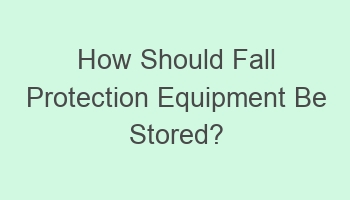How Should Fall Protection Equipment Be Stored?

Fall protection equipment should be stored properly to ensure its effectiveness and longevity. Storing fall protection equipment in a clean, dry, and well-ventilated area is crucial. This helps prevent damage from moisture and dust. Equipment should be stored away from direct sunlight and extreme temperatures. Regularly inspect for any signs of wear and tear. Consider using storage racks or cabinets to keep items organized. Implement a tracking system to monitor expiration dates and maintenance schedules. Properly storing fall protection equipment can extend its lifespan and ensure safety compliance.
Contents
| Store in a cool, dry place to prevent damage. |
| Fall protection equipment should be stored away from direct sunlight. |
| Inspect regularly for any signs of wear or damage. |
| Keep equipment clean and free from debris. |
| Follow manufacturer’s instructions for proper storage. |
- Replace damaged equipment immediately to ensure safety.
- Store equipment in a designated area to avoid confusion.
- Hang harnesses to prevent misshaping and maintain integrity.
- Check expiration dates on equipment and replace as necessary.
- Train employees on proper storage procedures to prolong equipment life.
What Are the Best Practices for Storing Fall Protection Equipment?
Fall protection equipment should be stored in a clean, dry, and well-ventilated area to prevent damage or degradation. It is essential to keep the equipment away from direct sunlight, chemicals, and extreme temperatures to maintain its integrity.
- Store fall protection equipment in a dedicated storage room or cabinet.
- Keep the equipment away from sharp objects or edges that could cause cuts or abrasions.
- Regularly inspect the storage area for any signs of damage or wear and tear.
Why Is Proper Storage Important for Fall Protection Equipment?
Proper storage is crucial for fall protection equipment to ensure its effectiveness and longevity. Storing the equipment correctly helps prevent damage, deterioration, or contamination that could compromise its safety features.
| Proper storage prolongs the lifespan of fall protection equipment. | Incorrect storage can lead to equipment failure during use, putting workers at risk. | Following manufacturer guidelines for storage helps maintain warranty coverage. |
How Can Fall Protection Equipment Be Organized in Storage?
When organizing fall protection equipment in storage, it is essential to keep similar items together for easy access and inventory management. Utilizing storage racks, shelves, or hooks can help maximize space and keep the equipment organized.
- Group harnesses, lanyards, and anchors in separate sections for clarity.
- Label storage bins or containers to identify the contents quickly.
- Implement a tracking system to monitor equipment usage and expiration dates.
Where Should Fall Protection Equipment Be Stored on a Job Site?
Fall protection equipment should be stored in a designated area on the job site that is easily accessible to workers but away from potential hazards or contaminants. It is advisable to keep the equipment close to where it will be used to minimize delays and ensure compliance with safety regulations.
| Store fall protection equipment in weatherproof containers or lockers for outdoor job sites. | Ensure that the storage location is well-marked and visible to all workers. | Regularly inspect the storage area for any damage or unauthorized access. |
When Should Fall Protection Equipment Be Inspected Before Storage?
Before storing fall protection equipment, it is crucial to inspect each item for any signs of damage, wear, or contamination. Conducting pre-storage inspections helps identify issues early and prevents using faulty equipment in the future.
- Inspect harnesses for fraying, cuts, or loose stitching.
- Check lanyards for any signs of abrasion, corrosion, or wear on the hardware.
- Verify that anchors are secure and free from any defects that could compromise their strength.
Which Fall Protection Equipment Requires Special Storage Conditions?
Certain fall protection equipment, such as self-retracting lifelines or rescue devices, may require special storage conditions to maintain their functionality and safety features. It is essential to follow manufacturer guidelines and recommendations for storing these specialized equipment items.
| Store self-retracting lifelines in a clean, dry environment to prevent rust or corrosion. | Rescue devices should be stored in a ready-to-use condition with all components intact. | Regularly inspect and test specialized equipment per manufacturer instructions to ensure proper function. |
How Can Fall Protection Equipment Be Protected from Environmental Damage in Storage?
To protect fall protection equipment from environmental damage in storage, consider using protective covers, cases, or containers that shield the items from dust, moisture, or UV exposure. Properly storing the equipment indoors can also help prevent degradation due to weather conditions.
- Invest in storage solutions that offer climate control features for temperature and humidity regulation.
- Avoid storing equipment near chemicals, solvents, or other substances that could cause deterioration.
- Clean and inspect the equipment regularly to remove any dirt, debris, or contaminants.
Who Is Responsible for Ensuring Proper Storage of Fall Protection Equipment?
The responsibility for ensuring the proper storage of fall protection equipment typically falls on the employer or site supervisor. They are accountable for establishing storage protocols, conducting regular inspections, and training workers on the correct procedures for storing and handling the equipment.
| Employers should provide adequate training on storage guidelines and best practices to all employees. | Site supervisors should enforce storage policies and procedures to maintain compliance with safety regulations. | Workers are responsible for following storage instructions and reporting any issues with equipment storage. |
What Are the Consequences of Improperly Storing Fall Protection Equipment?
Improperly storing fall protection equipment can have serious consequences, including equipment failure, injuries, or fatalities in the workplace. Neglecting proper storage practices can result in compromised safety, legal liabilities, and financial losses for companies.
- Equipment failure due to improper storage can lead to falls, injuries, or accidents on the job site.
- Lack of compliance with storage regulations can result in fines, penalties, or legal actions against the employer.
- Replacing damaged or improperly stored equipment can incur significant costs for companies.